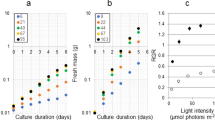Abstract
THE conversion efficiency of light energy into chemical energy, measured by production of organic matter, can be high with unicellular organisms. As photosynthesis becomes light saturated at relatively low light intensities, such high efficiencies are not usually obtained with high intensities of incident light. The saturation level, however, increases with increasing temperature. Blue-green algae grow well at high temperatures1–3, suggesting that they may be efficient producers of organic matter. As the protein content of algae in general is high, growth of these organisms could have important implications for food production, especially in tropical areas, where both light intensity and temperature are favourable. We have therefore investigated some parameters influencing yield of production of Anacystis nidulans at high light intensities.
This is a preview of subscription content, access via your institution
Access options
Subscribe to this journal
Receive 51 print issues and online access
$199.00 per year
only $3.90 per issue
Buy this article
- Purchase on Springer Link
- Instant access to full article PDF
Prices may be subject to local taxes which are calculated during checkout
Similar content being viewed by others
References
Haldall, P., Physiologia Pl., 11, 401–420 (1958).
Carr, N. G., and Whitton, B. A., The Biology of Blue-Green Algae, 360–367 (Blackwell, Oxford, 1973).
Fogg, G. E., Stewart, W. D. P., Fay, P., and Walsby, A. E., The Blue-green Algae, 129–142 (Academic, London, 1973).
Kratz, W., and Myers, J., Am. J. Bot., 42, 282–287, (1955).
Fogg, G. E., Proc. R. Soc., B 139, 372–397 (1952).
Goedheer, J. C., Biochim. biophys. Acta, 172, 252–265 (1969).
Gassner, E. B., Pl. Physiol. Lancaster, 37, 637–639 (1962).
Fischer, K., and Metzner, H., in Progr. Photosynth. Res., 2, (edit. by Metzner, H.), 547–551 (Tübingen, 1969).
Wassink, E. C., Kok, B., and Van Oorschot, J. L. P., in Algal Culture, from Laboratory to Pilot Plants, (edit. by Burlew, J. S.), 55–62 (Carn. Inst. Wash. Publ. no. 600, Washington, DC, 1953).
Oswald, W. J., in Proc. Workshop Bio-Solar Conversion, 38, (NSF/RANN report, 1973).
Rabinowitch, E., Photosynthesis and Related Processes, 1, 49 and 2, 1946 (Wiley, New York, 1945 and 1956).
Author information
Authors and Affiliations
Rights and permissions
About this article
Cite this article
GOEDHEER, J., HAMMANS, J. Efficiency of light conversion by the blue-green alga Anacystis nidulans. Nature 256, 333–335 (1975). https://doi.org/10.1038/256333a0
Received:
Accepted:
Issue Date:
DOI: https://doi.org/10.1038/256333a0
Comments
By submitting a comment you agree to abide by our Terms and Community Guidelines. If you find something abusive or that does not comply with our terms or guidelines please flag it as inappropriate.



